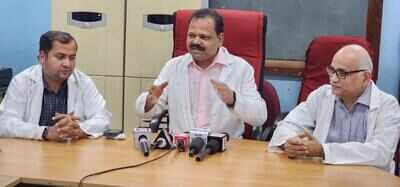Top Searches
GMC docs save senior citizen’s life with rare procedure to fix aortic aneurysm

Panaji: When Santosh Naik* was diagnosed with an aortic aneurysm, his fate was all but sealed. The 64-year-old could die at any moment.
The only option before him was a risky surgery not available in Goa, so costly it was beyond his means.
Enter the radiology department at Goa Medical College (GMC). Having started interventional radiology a while ago, the department’s doctors circumvented the surgery entirely, instead performing a relatively new procedure using a balloon — a first at the state’s premier healthcare institution.
Naik had initially reported to GMC with complaints of severe abdominal pain, and scans revealed a large aneurysm in his aorta, the major blood vessel that carries blood from the heart to the body. An aortic aneurysm is a bulge that occurs in the wall of the aorta.
At a press conference on Friday addressed by dean Dr S M Bandekar with head of radiology Dr Sanjay Sardessai and Dr Pawan Kumar who performed the procedure, Bandekar said that “The patient was treated with balloon technology, wherein the procedure is done without opening the patient”.
At any private facility, the procedure would cost upwards of Rs 10 lakh, but in Naik’s case, the cost was borne by the government. “A stent which costs over Rs 10 lakh was procured to do the life-saving procedure, even as under mediclaim, the patient was entitled to health insurance of Rs 3 lakh,” Bandekar said.
Bandekar said that health minister Vishwajit Rane approved the file to purchase the stent after he was informed how important it is that the poor man receives the treatment.
Naik was discharged three days after the procedure and is doing fine. “He was told that if he were to be operated on, he may not live. But with this new technology, we succeeded in saving him,” said Bandekar.
The benefit of having interventional radiology, Bandekar said, is that patients who can’t be operated on can still get relief.
Kumar said that the task of performing the procedure was made a little easier as the patient had no other co-morbidities.
Sardesai said that after starting interventional radiology, his department has treated almost 815 patients via the new technique, and 550 required vascular interventions.
“Suppose a patient is brought in who has bleeding in the intestine,” he said. “He will require surgery to find the source of the bleeding and to stop it. But under the new technique, the bleeding can be stopped and the patient can be saved without major surgery.”
* name changed to protect identity
The only option before him was a risky surgery not available in Goa, so costly it was beyond his means.
Enter the radiology department at Goa Medical College (GMC). Having started interventional radiology a while ago, the department’s doctors circumvented the surgery entirely, instead performing a relatively new procedure using a balloon — a first at the state’s premier healthcare institution.
Naik had initially reported to GMC with complaints of severe abdominal pain, and scans revealed a large aneurysm in his aorta, the major blood vessel that carries blood from the heart to the body. An aortic aneurysm is a bulge that occurs in the wall of the aorta.
At a press conference on Friday addressed by dean Dr S M Bandekar with head of radiology Dr Sanjay Sardessai and Dr Pawan Kumar who performed the procedure, Bandekar said that “The patient was treated with balloon technology, wherein the procedure is done without opening the patient”.
At any private facility, the procedure would cost upwards of Rs 10 lakh, but in Naik’s case, the cost was borne by the government. “A stent which costs over Rs 10 lakh was procured to do the life-saving procedure, even as under mediclaim, the patient was entitled to health insurance of Rs 3 lakh,” Bandekar said.
Bandekar said that health minister Vishwajit Rane approved the file to purchase the stent after he was informed how important it is that the poor man receives the treatment.
Naik was discharged three days after the procedure and is doing fine. “He was told that if he were to be operated on, he may not live. But with this new technology, we succeeded in saving him,” said Bandekar.
The benefit of having interventional radiology, Bandekar said, is that patients who can’t be operated on can still get relief.
Kumar said that the task of performing the procedure was made a little easier as the patient had no other co-morbidities.
Sardesai said that after starting interventional radiology, his department has treated almost 815 patients via the new technique, and 550 required vascular interventions.
“Suppose a patient is brought in who has bleeding in the intestine,” he said. “He will require surgery to find the source of the bleeding and to stop it. But under the new technique, the bleeding can be stopped and the patient can be saved without major surgery.”
* name changed to protect identity

About the Author
Bindiya ChariI'm a journalist with experience of more than a decade. I have covered politics, tourism, health and also done some off-beat stories. Apart from passion for journalism I have penchant for photography, trekking and travelling.
Start a Conversation
FOLLOW US ON SOCIAL MEDIA
FacebookTwitterInstagramKOO APPYOUTUBE









